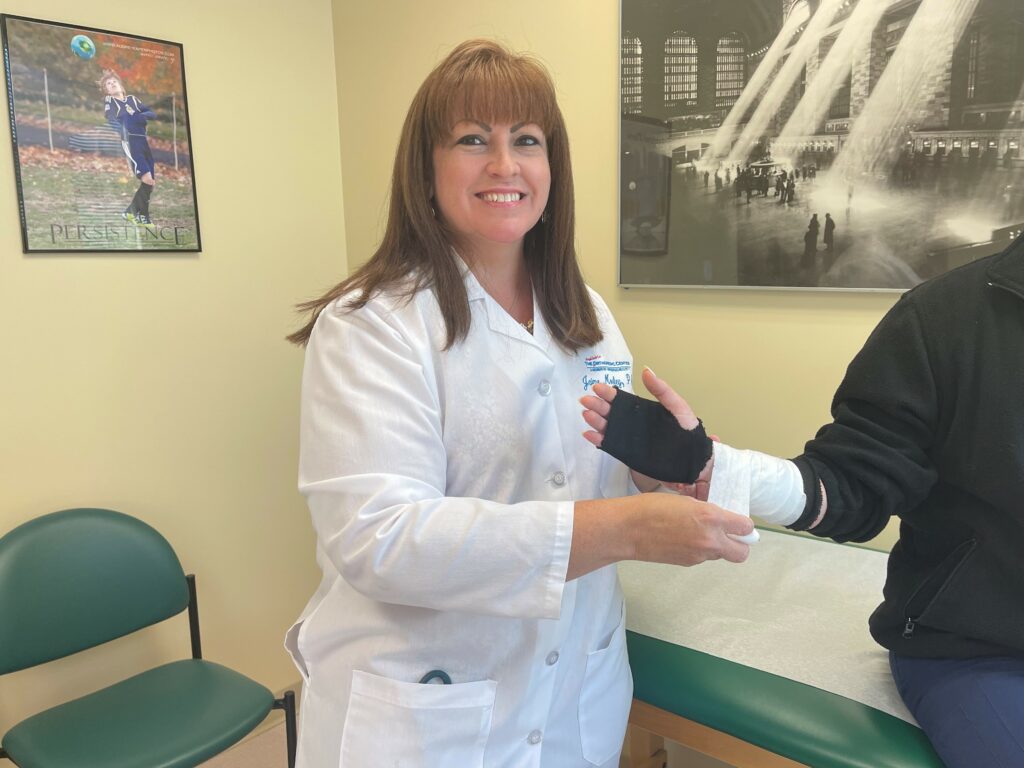A wrist sprain occurs when the ligaments of the wrist are stretched or torn. Ligaments are strong, fibrous bands of tissues linking the bones that make up the joint. These ligaments support the wrist and keep the bones in proper position. Wrist sprains are common injuries and usually occur when the wrist is bent or twisted forcefully, such as when falling onto an outstretched hand.
Severity of wrist sprains
Sprains can range from mild to severe. Mild sprains are a stretch or tiny tear in the fibers that make up the ligament.
In a moderate sprain, the ligaments are partially torn. This type of injury may involve some loss of function. With a severe sprain, the ligament is completely torn or is pulled off its attachment to the bone. These are significant injuries that require medical or surgical care. If the ligament tears away from the bone, it may take a small chip of the bone with it. This is called an avulsion fracture.
A sprained wrist is painful. Often there is swelling or bruising. The patient is often tender in the wrist joint. There may be complaints of popping or tearing inside the wrist. Even a wrist injury that seems mild with minimal swelling could still involve a torn ligament.
Similarly, an unrecognized (occult) fracture can be mistaken for a mild or moderate sprain. If left untreated, the fracture may not heal properly, and the patient could require surgery that might have been avoided with early, appropriate treatment. The most common example of this is an occult fracture of the scaphoid, one of the small bones in the wrist.
Wrist sprain diagnosis
Proper diagnosis and treatment by a pediatic orthopedist of a wrist injury are necessary to avoid long-term complications, including chronic pain, instability, and arthritis. Your doctor may order x-rays of your wrist to ensure that you do not have any broken bones. If more information is needed, a computerized tomography (CT) scan, magnetic resonance imaging (MRI) scan or MRI arthrogram may also be ordered. In an arthrogram, a special dye is injected into the wrist joint. This makes the joint and ligaments show up more clearly on an imaging study.
Treatments for wrist sprains
Treatment for a wrist sprain depends upon the severity of the injury. Mild to moderate wrist sprains may need to be immobilized with a wrist splint for one week or more. Recommended home care treatment using the RICE protocol includes:
- Rest. Try not to use your wrist for at least 48 hours.
- Ice. Apply ice immediately after the injury to keep the swelling down. Use cold packs for 20 minutes at a time, several times a day. Do not apply ice directly on the skin.
- Compression. Wear an elastic compression bandage to reduce swelling.
- Elevation. As often as possible, rest with your wrist raised up higher than your heart.
- Additionally, nonsteroidal anti-inflammatory drugs (NSAIDs), such as aspirin or ibuprofen, can help reduce pain and swelling. If pain and swelling persist for more than 48 hours, however, see a pediatric orthopedist.
Severe wrist sprains
Severe sprains may require surgery to repair the fully – torn ligament. Surgery involves reconnecting the ligament to the bone or using a tendon graft to reconstruct the injured ligament. Your pediatric orthopedist will discuss which option is best for your situation. Because wrist sprains usually result from a fall, be careful when walking in wet or slippery conditions. Wrist sprains also occur during sports such as skating, skateboarding, and boxing. Wearing wrist guards or protective tape when participating in these activities will help support your wrist and can prevent it from bending too far backward if you fall.
When to see a pediatric orthopedist
Wrist sprains are no small matter and if your child is in serious pain, or if you’re looking for a second opinion, please book a consultation with us!



